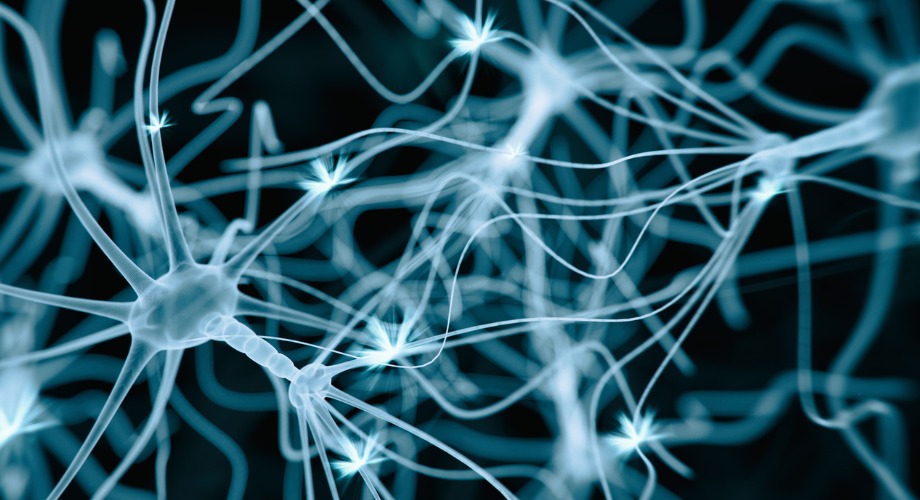
Neurons, pictured here, become damaged in both ALS and frontotemporal dementia. Researchers have found evidence that the disease process can be caused by highly reactive molecules in the brain that are known to increase in advanced age or after exposure to some environmental toxins. (Stock image)
A new clue to the cause of ALS and frontotemporal dementia
Scientists find evidence that reactive nitrogen molecules, abundant in old age, can trigger the disease process for two highly fatal conditions.
March 10, 2021
LA JOLLA, CA—Scientists at Scripps Research have discovered a plausible trigger for the most common form of amyotrophic lateral sclerosis (ALS, also commonly called Lou Gehrig’s disease), and a related form of dementia. The discovery could lead to better treatments for the diseases, which currently affect about 40,000 people in the US and are generally fatal.
The scientists, whose study is published in the Proceedings of the National Academy of Sciences of the USA, found evidence that key features of ALS and frontotemporal dementia can be triggered by reactive nitrogen molecules in the human brain. These reactive molecules, which naturally increase in the brain with aging, can set off a damaging process in which an important protein, known as TDP-43, clumps together and loses its function in affected brain cells.
“Not only did we show how this protein can start to aggregate in lab-dish cultures, we also saw signs of this process in the brains of people who died of frontotemporal dementia,” says study co-senior author Stuart Lipton MD, PhD, Step Family Foundation Endowed Chair in the Department of Molecular Medicine and founding co-director of the Neurodegeneration New Medicines Center at Scripps Research. Lipton is also a clinical neurologist who sees ALS and dementia patients.
The other co-senior author was Tomohiro Nakamura PhD, a senior staff scientist in the Lipton lab.
An enduring mystery
ALS kills neurons that control muscles, leading to a progressive paralysis that ultimately includes muscles needed for breathing. Although several well-known variants of ALS run in families and are clearly caused by gene mutations, the vast majority of cases are “sporadic,” arising in middle age with no clear cause.
Frontotemporal dementia, also called FTD, also usually arises in middle age with no clear cause, but can be triggered by some of the same rare gene mutations that cause familial ALS. It kills neurons in the brain’s frontal and temporal lobes, altering behavior initially and later progressing to other parts of the brain to become an Alzheimer’s-like dementia.
One feature that sporadic ALS and many cases of sporadic FTD have in common is the abnormal aggregation of a protein called TDP-43 within affected neurons. This protein normally works in the cell nucleus to help manage how key genes are expressed. But in ALS and certain cases of FTD, it largely disappears from the nucleus and aggregates in large, droplet-like compartments within the main body of the cell.
Many researchers suspect that the slow death of neurons in these diseases are due to this loss of TDP-43’s normal function and perhaps some toxic effect of its abnormal presence outside the nucleus. But what initially triggers the protein’s aggregation and disappearance from the nucleus has been an enduring mystery.
Lipton’s team found evidence that this process can be caused by highly reactive molecules that contain nitrogen. These reactive molecules, which include nitric oxide, are often byproducts of cell damage or stress. Their levels are known to rise in advanced age or after exposure to some environmental toxins.
The team demonstrated—in a series of experiments with cultured cells including neurons made from human stem cells—that reactive nitrogen molecules can attach to TDP-43 in a process called S-nitrosylation. This causes the TDP-43 proteins to clump together and disappear from the cell nucleus. (S-Nitrosylation is the outcome of a biochemical reaction that was originally discovered in Lipton’s laboratory during work on other proteins.)
The researchers also found evidence that the TDP-43 aggregation resulting from S-nitrosylation can drive a positive feedback loop in which levels of reactive nitrogen molecules in affected neurons rise higher still—inducing further TDP-43 aggregation.
The team also showed that TDP-43 aggregation induced by S-nitrosylation can spread from affected neurons to other, neighboring neurons, as appears to happen in ALS and FTD.
Countering the dangerous process
The scientists observed in their experiments that neurons in which TDP-43 aggregates show signs of the loss of TDP-43’s function as well as other potential causes of injury consistent with observations in ALS/FTD cases.
Moreover, neurons containing TDP-43 that were exposed to compounds inducing S-nitrosylation—compounds found in some environmental pollutants—started to die, whereas neurons containing a genetically modified form of TDP-43 that resists S-nitrosylation were preserved. Similarly, in a mouse model of TDP-43 spread, the researchers were able to prevent a key adverse effect of aggregation with a compound that blocks nitric oxide production—suggesting again that reactive nitrogen compounds are the upstream cause of these adverse effects.
The team also studied autopsied brain tissue from people who died with FTD, and found even higher levels of S-nitrosylated TDP-43 than those seen in the cell culture experiments. Their analysis of human brains also suggested that the S-nitrosylated TDP-43 had aggregated in the same distinctive way seen in the cell-based experiments.
“These findings support the hypothesis that aging or environmental factors—or both—can trigger ALS by increasing the levels of reactive nitrogen molecules,” Lipton says. “Targeting these reactive nitrogen molecules or the resulting S-nitrosylated TDP-43 may be an effective strategy for treating ALS and frontotemporal dementia.”
The study, “S-Nitrosylated TDP-43 triggers aggregation, cell to cell spread, and neurotoxicity in hiPSCs and in vivo models of ALS/FTD” was authored by Elaine Pirie, Chang-Ki Oh, Xu Zhang, Xuemei Han, Piotr Cieplak, Henry Scott, Amanda Deal, Swagata Ghatak, Fernando Martinez, Gene Yeo, John Yates III, Tomohiro Nakamura and Stuart Lipton.
The research was supported in part by the National Institutes of Health (R01NS086890, DP1 DA041722, R01 DA048882, RF1 AG057409, R01 AG056259, R01 AG061845, P41 GM103533).
For more information, contact press@scripps.edu

